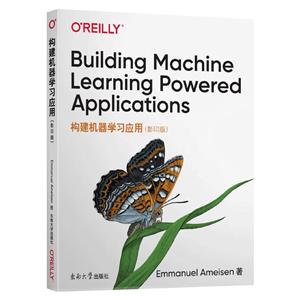-
>
决战行测5000题(言语理解与表达)
-
>
软件性能测试.分析与调优实践之路
-
>
第一行代码Android
-
>
深度学习
-
>
Unreal Engine 4蓝图完全学习教程
-
>
深入理解计算机系统-原书第3版
-
>
Word/Excel PPT 2013办公应用从入门到精通-(附赠1DVD.含语音视频教学+办公模板+PDF电子书)
构建机器学习应用(影印版)(英文版) 版权信息
- ISBN:9787564189518
- 条形码:9787564189518 ; 978-7-5641-8951-8
- 装帧:一般胶版纸
- 册数:暂无
- 重量:暂无
- 所属分类:>
构建机器学习应用(影印版)(英文版) 本书特色
作者Emmanuel Ameisen是一名经验丰富的数据科学家,他领导着一个人工智能教育项目群,通过代码片段、插图和截图以及对行业领袖的采访内容展示实用的机器学习概念。 本书**部分教授如何设计一个机器学习应用程序并评估效果;第二部分介绍如何构建一个可用的机器学习模型;第三部分演示改进模型的方法,让模型满足你*初的设想;第四部分介绍应用部署和监测策略。 这本书将帮助你: 定义产品目标,确立一个机器学习问题 快速构建一个端到端的机器学习流水线并获取一个初始数据集 培训和评估机器学习模型并解决性能瓶颈 在生产环境中部署和监测模型
构建机器学习应用(影印版)(英文版) 内容简介
学习设计、构建和部署机器学习(ML)应用所需的技能。通过这本实用的教程,你将构建一个机器学习驱动的示例应用程序,将很初的想法转化成可部署的产品。数据科学家、软件工程师和产品经理一一无论经验丰富的的专家还是刚刚入门的新手一一都可以循序渐进地学习构建实际的机器学习应用程序所涉及的工具、很好实践和技术挑战。 作者Emmanuel Ameisen是一名经验丰富的数据科学家,他领导着一个人工智能教育项目群,通过代码片段、插图和屏幕截图以及对行业的采访内容展示实用的机器学习概念。本书部分教授如何设计一个机器学习应用程序并评估效果;第二部分介绍如何构建一个可用的机器学习模型;第三部分演示改进模型的方法,让模型满足你很初的设想;第四部分介绍应用部署和监测策略。 这本书将帮助你: 定义产品目标,确立一个机器学习问题; 快速构建一个端到端机器学习流水线并获取一个初始数据集; 培训和评估机器学习模型并解决性能瓶颈; 在生产环境中部署和监测模型。
构建机器学习应用(影印版)(英文版) 目录
Preface
Part I. Find the Correct ML Approach
1. From Product Goal to ML Framing
Estimate What Is sible
Models
Data
Framing the ML Editor
Trying to Do It All with ML: An End-to-End Framework
The Simplest Approach: Being the Algorithm
Middle Ground: Learning from Our Experience
Monica Rogati: How to Choose and Prioritize ML Projects
Conclusion
2. Createa Plan
Measuring Success
Business Performance
Model Performance
Freshness and Distribution Shift
Speed
Estimate Scope and Challenges
Leverage Domain Expertise
Stand on the Shoulders of Giants
ML Editor Planning
Initial Plan for an Editor
Always Start with a Simple Model
To Make Regular Progress: Start Simple
Start with a Simple Pipeline
Pipeline for the ML Editor
Conclusion
Part II. Build a Working Pipeline
3. Build Your First End-to-End Pipeline
The Simplest Scaffolding
Prototype of an ML Editor
Parse and Clean Data
Tokenizing Text
Generating Features
Test Your Workflow
User Experience
Modeling Results
ML Editor Prototype Evaluation
Model
User Experience
Conclusion
4. Acquire an Initial Dataset
Iterate on Datasets
Do Data Science
Explore Your First Dataset
Be Efficient, Start Small
Insights Versus Products
A Data Quality Rubric
Label to Find Data Trends
Summary Statistics
Explore and Label Efficiently
Be the Algorithm
Data Trends
Let Data Inform Features and Models
Build Features Out of Patterns
ML Editor Features
Robert nro: How Do You Find, Label, and Leverage Data?
Conclusion
Part III. Iterate on Models
5. Train and Evaluate Your Model
The Simplest Appropriate Model
Simple Models
From Patterns to Models
Split Your Dataset
ML Editor Data Split
Judge Performance
Evaluate Your Model: Look Beyond Accuracy
Contrast Data and Predictions
Confusion Matrix
ROC Curve
Calibration Curve
Dimensionality Reduction for Errors
The Top-k Method
Other Models
Evaluate Feature Importancek
Directly from a Classifier
Black-Box Explainers
Conclusion
6. Debug Your ML Problems
Software Best Practices
ML-Specific Best Practices
Debug Wiring: Visualizing and Testing
Start with One Example
Test Your ML Code
Debug Training: Make Your Model Learn
Task Difficulty
Optimization Problems
Debug Generalization: Make Your Model Useful
Data Leakage
Overfitting
Consider the Task at Hand
Conclusion
7. Using Classifiers for Writing Recommendations
Extracting Recommendations from Models
What Can We Achieve Without a Model?
Extracting Global Feature Importance
Using a Model's Score
Extracting Local Feature Importance
Comparing Models
Version 1: The Report Card
Version 2: More Powerful, More Unclear
Version 3: Understandable Recommendations
Generating Editing Recommendations
Conclusion
Part IV. Deploy and Monitor
8. Considerations When Deploying Models
Data Concerns
Data Ownership
Data Bias
Systemic Bias
Modeling Concerns
Feedback Loops
Inclusive Model Performance
Considering Context
Adversaries
Abuse Concerns and Dual-Use
Chris Harland: Shipping Experiments
Conclusion
9. Choose Your Deployment Option
Server-Side Deployment
Streaming Application or API
Batch Predictions
Client-Side Deployment
On Device
Browser Side
Federated Learning: A Hybrid Approach
Conclusion
10. Build Safeguards for Models
Engineer Around Failures
Input and Output Checks
Model Failure Fal
构建机器学习应用(影印版)(英文版) 节选
“很多关于机器学习的书都跳过了*困难的部分:提炼问题、调试模型和为客户部署。但本书关注的正式这些内容,可以让你的项目从一个想法变成具有影响力的产品。” ——Alexander Gude (Intuit公司的数据科学家)
构建机器学习应用(影印版)(英文版) 作者简介
Emmanuel Ameisen是Stripe公司的机器学习工程师,曾经为Local Motion和Zipcar公司实施并部署了预测分析和机器学习解决方案。最近,他正在领导洞见数据科学的人工智能项目群,指导着100多个机器学习项目。他拥有法国三所大学的人工智能、计算机工程和管理硕士学位。
- >
朝闻道
朝闻道
¥8.8¥23.8 - >
月亮与六便士
月亮与六便士
¥15.1¥42.0 - >
有舍有得是人生
有舍有得是人生
¥17.1¥45.0 - >
小考拉的故事-套装共3册
小考拉的故事-套装共3册
¥36.7¥68.0 - >
伯纳黛特,你要去哪(2021新版)
伯纳黛特,你要去哪(2021新版)
¥21.9¥49.8 - >
姑妈的宝刀
姑妈的宝刀
¥9.0¥30.0 - >
经典常谈
经典常谈
¥12.7¥39.8 - >
名家带你读鲁迅:朝花夕拾
名家带你读鲁迅:朝花夕拾
¥16.3¥21.0
-
”互联网+“时代计算机算法的应用及其实践研究
¥19.9¥59 -
微服务设计
¥52.8¥69 -
图说深度学习:用可视化方法理解复杂概念
¥109¥188 -
计算机基础
¥17.2¥31 -
改变未来的九大算法
¥50¥68 -
生成式AI入门与AWS实战
¥77.8¥99.8





















